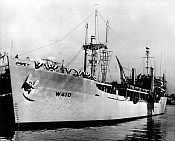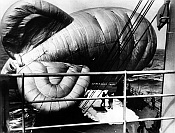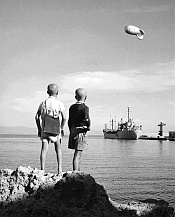
The Coast Guard Cutter Courier -
A "Battleship Without Guns"
By John Schneider, W9FGH
www.theradiohistorian.org
Copyright 2011 -
John F. Schneider & Associates, LLC
(Click on photos to enlarge)
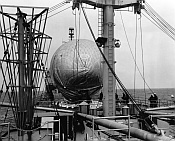
One of the 69 x 35 ft. helium balloons has been inflated and is preparing to raise the 900 ft. long cable that serves as the Courier’s medium wave antenna. The two inverted pyramids to the left are the ship’s shortwave antennas. (author’s collection)
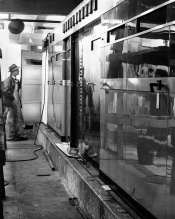
Voice of America
engineer Jean Seymour inspects the front panel of the RCA 150 kW medium wave
transmitter during its installation on the USCGC Courier, January 9, 1952.
(author’s collection)
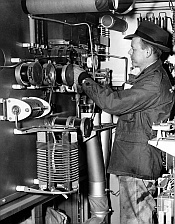
Engineer Jean Seymour is
shown inspecting some of the low-level RF components inside one of the RCA
transmitter’s many cabinets.
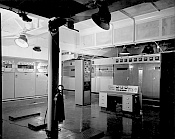
An interior view of the Courier's transmitter room

This is a view of the Courier during the later years of its VOA mission. (USCGC Courier/VOA
Memorial Foundation photo)
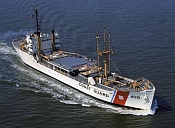
This was how the Courier looked during the last years of
its life, when it operated as a training vessel in Yorktown, Virginia. (USCGC Courier/VOA Memorial Foundation
photo)
A
number of powerful VOA shortwave transmitting facilities were already broadcasting
from the United States, but in 1949 the Soviet Union began jamming those
American signals. Their powerful jamming
transmitters on the VOA frequencies created walls of noise and interference
that blocked reception of the American signals, which were considerably weaker
because of their long transmission distances.
To break through the jamming, the VOA needed to operate transmitters
that were closer to its target regions. Beginning
in the early 1950s, overseas transmitter plants were built or leased in
Tangiers, Philippines, Okinawa, Kavala, Greece and Liberia.
At
the same time, the VOA proposed to build a fleet of shipboard radio
transmitters that could quickly and easily move to wherever they were needed to
serve as temporary relay stations. In
response to the proposal, the Department of State created the program
“Operation Vagabond” in April, 1951. At
first six vessels were contemplated, but in the end budget constraints imposed
by Congress limited the project to just one ship. To avoid political controversy, this ship would
be unarmed and operate under the command of the US Coast Guard. It would not broadcast from open waters on
the high seas, but only from inside the territorial waters of a friendly
country that granted permission.
The
project was inspired by a World War II experiment, when the VOA was operated by
the Office of War Information. A 5 kW
medium wave transmitter was installed aboard the battleship USS Texas, and on
November 8, 1942, it broadcast news of the impending invasion of North Africa
to the people of French Morocco. The
experiment had been considered a success, even though when the big guns of the
battleship were opened up to bombard the coastline, the vibrations caused major
damage to the transmitter.
At
her commissioning, Dr. Wilson Compton, head of the U.S. International
Information Administration, noted that Courier
was "designed to provide another electronic weapon to combat Soviet
jamming transmitters and to enable the Voice of America to cover areas beyond
the reach of present broadcasts." Immediately
afterwards, the Courier visited
Washington, DC, where President Truman inspected the ship and made a worldwide
broadcast from her deck. That was
followed by a shakedown cruise to the Panama Canal, where test broadcasts were
performed on 6110 and 9690 kHz (35 kW), and 1510 kHz medium wave (150 kW) using
the call sign KU2XAJ.
On
August 22, 1952, the Courier arrived
at its permanent station -- an undisclosed location off the Greek island of
Rhodes, eleven miles southwest of Turkey in the Aegean Sea. Two locations were established for
broadcasting – at the pier of the main harbor, and at anchor a mile out from
the Saint Nicholas Lighthouse. The first
broadcasts to behind the Iron Curtain began on September 7, 1952. The Courier
was on the air for 11¼ hours each day,
seven days a week, relaying programs in 13 languages.
VOA programs were received via shortwave
from the U.S. on a bank of Collins 51-J receivers, and recorded onto disc for
later broadcast. These recording lathe turntables
were mounted on specially-designed gyroscope-stabilized cradles that stayed
level as the ship rolled with the seas. The
shipboard facilities also included a small broadcast studio and control room, which
allowed for the possibility of local broadcasts if needed.
On the forward deck, four inverted pyramid antennas
were used for the shortwave transmissions.
They were fed by a large impedance matching network below deck. During the first few years, the medium wave antenna
was a steel cable that was winched up to 900 feet altitude during the
broadcasts, carried aloft by one of five 69 x 35 ft. helium balloons, which
were launched from a platform amidships.
There were 600 bottles of helium stored aboard the ship, and it took
many coastguardsmen to inflate the balloons and send them aloft. However, on several occasions the balloons' cables
snapped during heavy windstorms, and the balloons drifted
free over Turkey where they damaged private property. After that experience, VOA engineer Ivan Boor
designed an inverted delta antenna that was suspended from the two ships masts. It was less efficient than the long cable but
solved the problem of the balloons.
Another complication that the Courier suffered was on the receiving end of the operation. Picking up the programs on the ship proved to
be less than ideal because of massive interference from the ship’s own
transmitters, and because of interference from Russian jamming
transmitters. A faraday shield was built
at the stern of the ship, and the receive antennas were located behind the
shield in an attempt to minimize the strong signals from the transmit antennas
on the bow, but this was only partially effective. Eventually, a separate site with elaborate
receive antennas was constructed on a hill overlooking the harbor, where the
programs were picked up and sent back to the ship over a VHF link. .
END OF THE MISSION:
In the long run, having a movable seagoing transmitter was not
as useful as was originally envisioned, and the Courier’s signal range was being hampered by the limitations of its
shipboard antennas. As the Soviets
increased their jamming power, higher transmitting power and more efficient antennas
were needed. Finally, in 1964, the VOA inaugurated
a land-based transmitting station on the Island of Rhodes. It was equipped with a 500 kW medium wave
transmitter and two 50 kW shortwave units.
The last broadcasts from the Courier
were made on May 17, 1964. With its usefulness
at an end, the transmitting equipment and generators were offloaded and given to
the Greek Government, and she set sail for home. Today, the Courier still holds the record for
the longest overseas deployment: from July
17, 1952 to August 13, 1964, she spent no time in United States territorial
waters.
On August 25, the Courier was turned over to the Coast Guard
Reserve Training Center at Yorktown, Virginia, where she served as a reserve
training vessel from 1966 to 1970. In
June, 1970, she suffered damage to her bow when she collided with the USS
Pocono. The Courier was finally
decommissioned in 1972 and scrapped in 1975, ending a colorful career as one of
the world’s most unique broadcast facilities.
For
more information, and some interior views of the Courier, see this newsreel clip:
https://www.youtube.com/watch?v=Dzl7pI16Ujo
REFERENCES:
- “Popular Mechanics´
magazine, December, 1952, page 94. https://books.google.com/books?id=qNwDAAAAMBAJ&printsec=frontcover#v=onepage&q&f=false
- "USCGC Courier
(WAGR-410), A Battleship Without Guns” by Captain John T. Andrews, USCG (ret)
and others
- Wikipedia: https://en.wikipedia.org/wiki/USCGC_Courier_(WAGR-410)
Wikipedia: https://en.wikipedia.org/wiki/Voice_of_America - USCGS Courier historic
image gallery: http://www.uscg.mil/history/webcutters/courier_wagr410_photos.asp
- Modesto Radio Museum http://www.modestoradiomuseum.org/voa%20courier.html
- On the Shortwaves http://www.ontheshortwaves.com/USCGC_Courier/Courier.html
- USCGS Courier
Association: http://courier410.wixsite.com/couriervoa/association
- History of International
Broadcasting by James Wood
- Voice of America: A
History by
Alan L. Heil, Jr.
- K6JDH page on
QRZ.com: https://www.qrz.com/db/K6JHD
NOTE: This article appeared in the Spectrum Monitor Magazine, December, 2016.
www.theradiohistorian.org
John F. Schneider & Associates, LLC
Copyright, 2011
